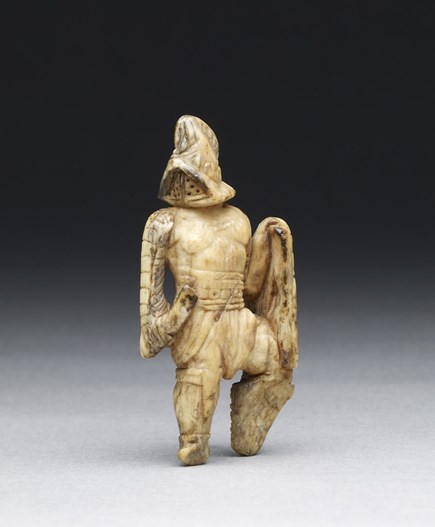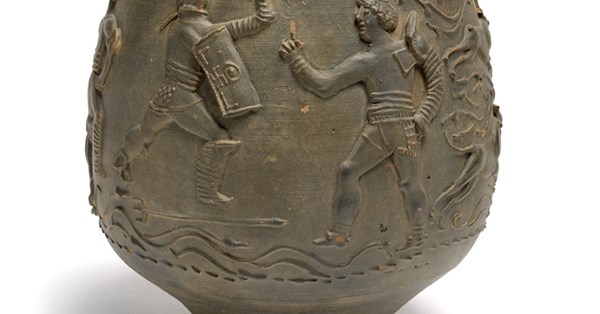IN COLCHESTER, towards the end of the second century, the hottest ticket in town was to see the beast-hunters Secundus and Mario take on a bear, followed by the gladiators Memnon and Valentinus fighting. One spectator enjoyed their day out at Colchester’s arena so much they had an intricate blackware vase created as a souvenir, depicting in detail the beast hunt, gladiatorial combat, and warm-up act of a dog chasing a hare and stags.
Found in 1853, the Colchester Vase is one of the star exhibits in Gladiators of Britain, a touring exhibition in partnership with the British Museum, currently at Dorchester Museum. Recent research on the vase, made around AD 175, reveals that the inscription recording the names of the arena performers was cut into wet clay before the pot was fired. This points to the commemoration of an actual spectacle that took place in Roman Colchester. These figures and names were part of the conception of the pot. Clearly a prized possession, showing no wear and tear from use, it is evidence ofnamed gladiators fighting for entertainment in Roman Britain. Possibly Colchester was a stop on gladiatorial tours.
“Gladiators of Britain” presents the possibility of Britons in the second and third centuries witnessing the same spectacles of violence and death, featuring the same gladiatorial superstars, as converts to the Early Church. Touring gladiators may have performed at the 17 Roman amphitheatres so far identified in Britain, the bloodied sand of Eastern Mediterranean and North African arenas still caked on their sandals.
Dorchester Museum builds a picture of an empire wide fascination with gladiatorial combat and its practitioners, lasting for 500 years. Gladiatorial combat originated with Etruscan funeral rites, in which high-status deaths were marked with duos fighting until one was slain. Bloody spectacle’s popular appeal led to the construction of amphitheatres throughout the empire. A copper sestertius coin from AD 223 shows Rome’s Colosseum, opened in AD 80, and seating 50, 000 spectators. At the centre of the coin, surrounded by the Colosseum’s arcades and awnings to give the crowd shade, two gladiators with swords are poised to go head to head.
A rusting helmet discovered by a farmer ploughing a Suffolk field in 1965, is one of the most significant objects pointing to gladiatorial entertainment in Britain. The purity of the Hawkesdon helmet’s brass, together with the visor and extended neck guard, identify it as being worn by a gladiator, not a soldier. When it was first crafted in Italy, in the latter decades of the first century, its high-quality metal would have shone like gold. The stamp on the helmet is similar to marks found on a helmet in the gladiatorial barracks in Pompei. Used by a Provocator, a class of gladiator who fought with a medium shield, a breastplate, and guards on the right arm and left leg, the Hawkesdon helmet could have been worn by a gladiatorial troop brought to celebrate Britain’s conquest, or the suppression of Boudicca’s rebellion in the decades following.
 © 2024 The Trustees of the British MuseumBone figurine depicting a gladiator of the murmillo class, found in Colchester, from first to second century AD
© 2024 The Trustees of the British MuseumBone figurine depicting a gladiator of the murmillo class, found in Colchester, from first to second century AD
Gladiator-inspired merchandise has been found throughout the empire, including a green-glazed helmet-shaped lamp made in Cologne in AD 200, and an identically shaped pottery version from Colchester, created half a century earlier. Lookalike lamps depicting gladiators standing, in defeat, and fighting, spanning AD 50 to 600, have been unearthed in Colchester, Italy, and Egypt. From Hadrian’s Wall to Africa, Roman subjects wanted souvenirs of arena spectacle.
Drawn from slaves, prisoners of war, criminals, and men who became the property of the wealthy, gladiators held the status of infamis, the lowest of the low. Despite the fame and adulation of crowds, gladiators had few rights. Their performances — and potential deaths — provided entertainment to celebrate military and political achievements and even birthdays.
To be commemorated after their deaths, gladiators paid into burial clubs. A marble tombstone, dating from AD 1 to 100, from Bodrum’s gladiator cemetery, shows in relief a figure bearing the large shield and crested helmet of a Secutor gladiator, the late gladiator named as Hilaros in the Greek inscription.
No gladiator gravestones have yet been found in Britian, but a gladiator graveyard in York is a smoking gun for an undiscovered amphitheatre in the city. In the early 2000s, the skeletal remains of 80 young men with overdeveloped right arms and trauma wounds were excavated in the city. One skeleton shows evidence of a large carnivore bite from a lion or bear. York’s resting place bears striking similarities to the burial site for arena combatants in Ephesus, with remains showing hammer blows to the head and decapitation.
St Paul’s imagery of running and fighting could refer to the games and entertainments of the arena. “I therefore so run, not as uncertainly; so fight I, not as one that beateth the air” (1 Corinthians 9.26). The church Father Tertullian criticised arena spectacle, because it made the audience uninhibited and emotionally volatile: “They love whom they lower; they despise whom they approve; the art they glorify, the artist they despise.”
Fighting the good fight took on a new meaning from the fourth century. Gladiatorial contests declined, challenged by the escalating costs for emperors and provincial governors of staging games, and the rise of Christianity as Rome’s official religion.
A short walk from the museum in Dorchester, or Durnovaria, as the Romans knew it, is the town’s Roman Town House, built in the early fourth century. Five Roman babies were buried in the grounds, close by the Town House’s mosaics and central heating, possibly infants unacknowledged by their father, and, therefore, without any rights to life. The more the Roman empire reveals itself, the more unfathomable it feels.
“Gladiators of Britian” is at Dorchester Museum and Art Gallery, High West Street, Dorchester, until 11 May, then touring to Northampton, Chester, and Carlisle.

















